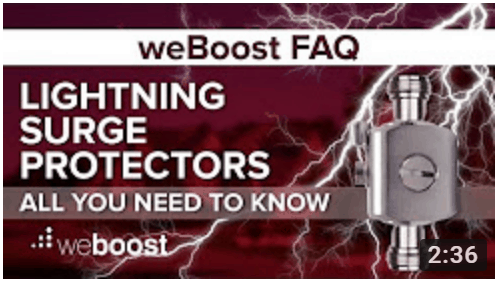Blog
How to Install a Lightning Surge Protector
November 8, 2022 — by NICHOLAS JONES
SHARE ARTICLE[Sassy_Social_Share total_shares="ON"]
A lightning surge protector plays important role in cell phone signal booster systems by preventing the booster from being damaged in the event lightning strikes the outside antenna.
Typically an outside antenna is placed on the roof of a home to best pick up signal from the cell tower. Naturally this location can make the outside antenna vulnerable to lightning strikes.
If lightning were to strike an outside antenna and no lightning surge protector were installed on the booster system, the energy from the lightning would flow through the antenna cable down to the amplifier unit and on to other connected components. The result? The electronics of the booster system would be fried.
With a lightning surge protector installed on the booster system, the energy from a lightning strike would pass through the antenna and cable to the lightning surge protector and be grounded at that point. With the energy harmlessly dissipated, the booster amplifier unit and connected components would be spared any damage.
We would then only need to replace the inexpensive surge protector cartridge, as shown in the above video at the 1:05 mark, to restore the lightning surge protector to functionally again.
Installing the lightning surge protector
Lightning surge protector installation is not difficult. But if you’re not comfortable tackling the job yourself, call an electrician. The steps are shown in the video starting at about the 1:15 mark.
Install the lightning surge protector near the outside antenna. To do this, attach the cable from the outside antenna to the lightning surge protector. A 2-foot cable is available from weBoost for this purpose, or you can use a short cable from any source.
Next, attach to the other side of the lightning surge protector the cable running to the signal booster amp unit. By the way, the lightning surge protector is bi-direction so it doesn’t matter which side of the LSP is connected to the antenna or to the amp. The lightning surge protector can’t be install “backwards.”
Now, attach a copper ground wire of up to 10 gauge to the lightning surge protector as shown in the video at about the 1:40 mark. Attach the other end of the ground wire to a grounding bus or grounding point. If you’re unsure of local requirements for grounding points, check local building codes. Finally, tighten all connections and you’re finished!
If lightning strikes
If lightning later strikes your outside antenna, just remove the replaceable cartridge from the surge protector as the video shows at about 2:05. Replace it with a new cartridge, and the lightning surge protector is back in business.
weBoost has lightning surge protectors for various types of cable, so you should be able to find a lightning surge protector that matches the cable your system uses.
If you have questions about a lightning surge protector, calling weBoost Customer Service or check the weBoost Online Support Center here.
If you’re wondering, there are no lightning surge protectors for vehicle boosters. The odds of your vehicle getting struck by lightning are very small. And if lightning happens to strike near your vehicle, the tires – as non-conductors of electricity – generally insulate the vehicle, its occupants and any electronics from damage or injury.
Cell phone need a boost in your home or vehicle? Click below to see a selection of cell phone signal boosters!
buttonbutton SHARE ARTICLE[Sassy_Social_Share total_shares="ON"]TAGS: How To
